New DiscoveriesJapan through the Looking Glass: Uchida Kuichi (attributed), Vermilioned Bridge, Nicco (ca. 1872) and the Russell Sturgis Photograph Collection
by Nicole J. Williams
Nicole J. Williams
Washington University in St. Louis
Citation: Nicole J. Williams, “Japan through the Looking Glass: Uchida Kuichi (attributed), Vermilioned Bridge, Nicco (ca. 1872) and the Russell Sturgis Photograph Collection,” Nineteenth-Century Art Worldwide 20, no. 1 (Spring 2021), https://doi.org/10.29411/ncaw.2021.20.1.5.
This work is licensed under a Creative Commons Attribution-NonCommercial 4.0 International License  unless otherwise noted.
unless otherwise noted.
Your browser will either open the file, download it to a folder, or display a dialog with options.
In the course of developing the exhibition Global Vistas: American Art and Internationalism in the Gilded Age (2020) for the Mildred Lane Kemper Art Museum at Washington University in St. Louis, I took a close look at the Russell Sturgis Photograph Collection in the university archives. An influential architect, critic, and art historian, Russell Sturgis (1836–1909) amassed more than twenty thousand photographs and photogravures to aid in his research and teaching. His collection, comprising approximately fifteen thousand images today, focuses on architecture, architectural ornament, and sculpture, of different cultures and historical periods.
A rare, unpublished albumen print in the Sturgis Collection, captioned Vermilioned Bridge, Nicco (ca. 1872; fig. 1), attracted my attention because it depicts the very act of photography. In front of the red-lacquered Shinkyō (Sacred Bridge) in Nikkō, Japan, a photographer accompanied by two assistants can be seen tending a portable darkroom, a curtained chamber for preparing and processing wet-plate photographs when working in the field (fig. 2). Remarkably, Vermilioned Bridge, Nicco is the only known photograph from the nineteenth century to show Japanese photographers at work on location.[1]
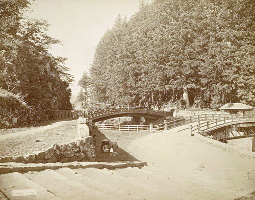
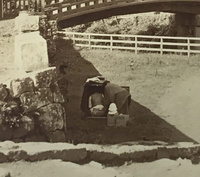
In this article, I attribute the photograph to renowned photographer Uchida Kuichi (1844–75). I suggest that Uchida adapted the Western invention of photography—its aesthetics, methods, and equipment—to Japanese artisanal traditions. I further explore the complex interplay between the photograph and the collection of which it is a part, showing how they bring into tension two visions of Japan: the modern industrial nation seen through the photographer’s lens and the quaint preindustrial culture that Sturgis imagined in his writings and attempted to salvage by collecting photographs.
Photography and Modernity in Meiji Japan
Attributing early Japanese photographs to specific photographers is a tricky business. Very few photographs from the Meiji period (1868–1912) were signed, and negatives regularly changed ownership as firms dissolved or combined. It was common for photographers to acquire negatives from older studios and reproduce those prints among their stock.
One element that can be helpful in making attributions is caption style. The opaque cartouche containing white English lettering on Vermilioned Bridge, Nicco is believed to be the mark of Hasegawa Kichijirō (active 1870s), the protégé of Uchida Kuichi as well as proprietor of Uchida’s studio in Yokohama following his death from tuburculosis in 1875. Hasegawa inherited Uchida’s vast collection of negatives, which included “Views of places of note,” according to a studio advertisement.[2] Nine more photographs in the Sturgis Collection bear a similar style of caption. One of these pictures, titled View from Bridge Tagonourabashi, to Fudzisan, is known in multiple prints. The Royal Collection Trust recently attributed an identical image to Uchida and the print, as well as the caption written on the negative, to Hasegawa.[3] Vermilioned Bridge, Nicco was likely printed from an original negative by Uchida, in the studio of Hasegawa or a successor of both firms.
Uchida Kuichi was born in 1844 in Nagasaki, the only city allowed to trade with Western powers by the Tokugawa Shogunate. He learned wet-plate photography from a Dutch physician and opened his own studio in Osaka in 1865. The next year he moved the business to Yokohama, a bustling treaty port recently opened to foreign commerce. By 1869 Uchida had established a second studio in Tokyo. He became known as the preeminent native photographer in Japan during the early Meiji era.
As art historian Luke Gartlan has shown, Uchida’s success was linked to the spirit and aims of the Meiji Restoration, which launched a sweeping program of modernization and Westernization that transformed the country from an insulated feudal society into a modern industrial power. Uchida drew clientele from the expanding ranks of foreign expatriates and tourists in Japan. Progressive Japanese intellectuals and politicians also patronized his studios. Uchida was directly allied with the new regime. The imperial household commissioned him to photograph Emperor Meiji on two occassions; he was the only photographer granted the honor of a sitting with the sovereign. In 1872 Uchida traveled extensively with the imperial delegation on a tour of the Kansai region and Kyūshū. A portfolio of views resulting from that trip emphasizes modernization projects, such as the Osaka Mint and Shuseikan industrial complex in Kagoshima. For several photographs in the portfolio, Uchida posed conspicuously wearing foreign clothing, reflecting his self-conscious status as imperial photographer as well as his desire to project a modern, Westernized identity that aligned with the Meiji agenda.[4]
Understanding that the practice of photography could not only portray but also exemplify the modernizing process in Japan, Uchida turned the camera on his own photographic operation in Vermilioned Bridge, Nicco. The picture shows photographers with the equipment necessary for the wet-collodion process assembled in a slice of shadow. The method required that outdoor photographers transport numerous implements and chemicals, since each plate had to be coated and sensitized immediately prior to exposure and developed rapidly after exposure, while still wet. In the photograph, the curtain of a mobile dark box draws back to expose a crouching photographer. Two wooden crates, probably holding fragile glass plates, lie beside a satchel or basket cradling glass chemical bottles. While these materials advertise Uchida’s mastery of the complicated procedures of wet-plate photography, they also embody the modernization of Japan.[5] Recently introduced from the West, photography and the mostly imported supplies essential for its practice were “firmly and explicitly connected to the process of industrialization and the building of a modern Japanese nation.”[6] A popular expression from 1872 called photographic technology one of seven “standard paraphernalia of civilization and enlightenment” (bunmei kaika nanatsu dōgu), along with newspapers, gaslights, steam engines, the postal service, dirigible balloons, and exhibitions.[7]
If Uchida wanted to dramatize the arrival of a new age in Japan, he could choose no more resonant mise-en-scène than the foot of the Shinkyō Bridge. Spanning the gorge of the Daiya River, the seventeenth-century red-lacquer wooden bridge marked the entrance to the shrines and temples of Nikkō, including the opulent mausolea of the first Tokugawa shogun, Ieyasu, and his grandson, Iemitsu. For visitors during the Meiji era, the funereal aura of the complex conjured the passing of the era of the shoguns. In “Notes of a Trip to Nikko,” published in the English-language newspaper The Far East that served Yokohama’s foreign community, a foreign traveler called the grounds “the resting place” for the founder of the “dynasty of shogoons which, after retaining power during two centuries and a half, has only just come to an end.”[8] Illustrations of “very excellent views taken by Mr. Uchida” accompanied the article, indicating he sold images of Nikkō by the time of its publication in April 1873.[9]
Uchida was among the earliest photographers to take and disseminate pictures of Nikkō.[10] The mountain town was new as a tourist site and pictorial subject in the early Meiji era. During the Edo period, Nikkō had been a place of pilgrimage for the Tokugawa rulers and their retinues, but entry to its shrines and mausolea had been largely restricted for commoners. Accordingly, images of the complex were few and limited to pilgrimage mandalas and scenes of festivals. In the 1870s, Meiji authorities permitted greater access to Japanese and foreign sightseers, for whom travel restrictions beyond the treaty ports and their environs were eased. Many visitors arrived in Nikkō from Tokyo, a trip that could be completed in two days by jinrikisha (rickshaw). The architectural splendors and natural beauty of the region, publicized by Uchida and other entrepreneurial picturemakers, turned Nikkō into Japan’s most popular tourist destination by the mid-1870s and a lucrative part of later photographers’ repertoires of views.[11]
As more and more sightseers flocked to Nikkō, use of the Shinkyō was reserved for the emperor; all “ordinary mortals” crossed the parallel public bridge, seen to the immediate right of Uchida’s party.[12] The men’s position nearer to the public bridge than the Shinkyō affirms the authority of Emperor Meiji, even in his physical absence. It reproduces the spatiality of imperial symbolism that ordered the topography of the new Japan.
Recently historian Morris Low has argued that the Meiji Restoration is better understood “as a period of transition rather than a revolution which obliterated the past.” The Japanese experienced modernity not as a radical break from the past, but as a syncretic blending of the forces of industrialization and internationalism with the “preservation of cultural traditions,” such as the centuries-old emperor system.[13] In many ways, Vermilioned Bridge, Nicco also bridged the past and the present, the old Japan and the new Japan. The photograph remained rooted in local cultural traditions as much as it stressed the nation’s ability to transform itself in the image of the West.
Though it emphatically asserts itself as a work in the new, Western medium of photography, Vermilioned Bridge, Nicco adopted earlier modes of perceiving and representing the landscape in Japan. Views of famous places, known as meisho-e, had formed a genre of indigenous art since the late ninth century. With the growth of domestic tourism in the Edo period, ukiyo-e woodblock printmakers embraced travel and sightseeing subjects.[14] Uchida borrowed compositional strategies from prints in the tradition of meisho-e. His photograph exploits large, geometrical blocks of tone familiar from Japanese prints. It employs a series of sharp, interlocking diagonals to evoke the experience of traveling through the landscape. The road to Nikkō’s shrines and temples cuts across the extreme foreground, then snaps backward to intersect with the span of the Shinkyō. This zigzagging route of travel, both across and into the picture plane, recalls prints by Katsushika Hokusai (1760–1849), including Sekiya Village on the Sumida River from his famous series Fugaku sanjūrokkei (Thirty-Six Views of Mount Fuji, ca. 1830–32; fig. 3). Other landscapes by Hokusai featuring artisans working at various occupations, such as the carpenters in Harumichi no Tsuraki (ca. 1835–36; fig. 4)—another graphic composition similar to Vermilioned Bridge, Nicco—may have inspired Uchida’s decision to depict photographers with their tools in the field. Such connections would have made Uchida’s photograph appealing to Western buyers, for whom the woodblock print, especially the work of Hokusai, represented the pinnacle of Japanese art.[15]
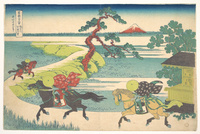
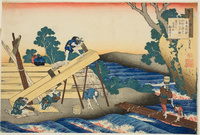
Uchida also extended long-standing traditions of Japanese workmanship, despite the novelty of the wet-plate process and the broader changes to practices of craftsmanship wrought by industrialization. A closer look at the darkroom and photographers within Vermilioned Bridge, Nicco refutes the common assumption that native studios simply copied the techniques of their Western counterparts. In Europe and the United States, photographers elevated mobile darkrooms like this one on a tripod, folding frame, or similar apparatus. An illustration of a dark box raised on a foldaway table appeared in Hermann Wilhelm Vogel’s Handbook of the Practice and Art of Photography, printed in Philadelphia in 1871 (fig. 5). However, the darkroom in the photograph rests directly on the ground. Japanese artists and artisans customarily worked on the ground rather than at a table or bench. In the memoir of his experiences in Japan in the 1870s and 1880s, Japan expert Edward Sylvester Morse observed with bemusement, “The blacksmith sits on the ground at his work, though the helper stands; the carpenter saws and planes on the floor, and it is an odd sight to see the carpenter’s shop with no bench or vise.”[16] The photograph reveals a surprising adaptation of Western camera technology to the local convention of floorwork.
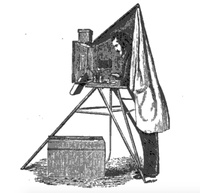
The appearanace of three men, one inside and two outside of the dark box, illuminates the collective nature of authorship in early Japanese studios, where it was common for a lead photographer to direct a team of assistants or apprentices. As Karen M. Fraser has noted, this arrangement probably carried over aspects of the apprentice system established among Japanese merchants.[17] It is conceivable that the master Uchida himself squats in the darkroom, surrounded by junior members of his team. The squatting man’s foreign-style dress shirt, vest, and trousers, along with two white bowler hats stacked prominently atop the plate boxes, resemble the attire of a modern gentleman that Uchida assumed for other photographs. A second man stoops to peer into the darkroom; the equipment clustered at his feet implies his readiness to assist with chemicals and plates. A third man stands beside the stone retaining wall and gazes to the right, reinforcing the thrust of the roadway. His obscured lower body telegraphs the subordinate status of an aide. Either of the two assistants may be Hasegawa. These possibilities are worth consideration, since they raise interesting questions about Hasegawa’s motives for reissuing the picture after Uchida’s death. Hasegawa marketed his connections to his former master to build his reputation and client base. After Uchida’s passing, he placed a notice in The Japan Gazette proclaiming his studio “late of UCHIDA.”[18] If the photograph depicted Uchida, or Uchida and Hasegawa together, it would have bolstered Hasegawa’s ability to position himself as Uchida’s heir.
Russell Sturgis and Visual Salvage
How Russell Sturgis acquired Vermilioned Bridge, Nicco and his collection of 172 photographs from Japan at Washington University remains uncertain.[19] Having never visited Japan, he likely obtained the prints while living and traveling in Europe between the 1870s and 1880s. After a lengthy stay abroad from 1880 to 1884, Sturgis brought back to New York City what one writer called “probably the best collection of photographs and drawings of buildings and other decorations that was to be found in America.”[20] Alternatively, Sturgis may have purchased the photographs from dealers in New York City, where he lived. Uchida’s pictures appear to have been available for purchase in New York by the early 1870s.[21]
Sturgis, though an avid collector of photographs, doubted the creative potential of the medium. As the century closed and new currents of pictorialism intensified debates about photography’s status as art, Sturgis continued to define photography as a mechanical trade.[22] Yet he prized its referential fidelity as a tool for the study of artworks and architecture. In a Scribner’s Magazine article titled “The Lesson of the Photograph,” Sturgis explained:
It was that a photograph was a mere glass through which one saw the veritable object which he wished to study. The artistical character was not in the photographic picture, but in the object which it reproduced. Through the ugly purplish brown of a silver-print more of the truth concerning the church front . . . was visible than could be seen through any drawing. . . . This is the essence of the photograph, that it preserves every record, with some drawbacks and shortcomings, of what is put before it.[23]
Sturgis championed the didactic potential of photography in the fields of art and architectural studies. Indeed, he believed so strongly in the instructional value of photographs for architects that study abroad, long considered the cornerstone of architectural education, no longer seemed necessary. “It is better to sit at home with a plan and twenty photographs with a sense of what that architecture truly means,” Sturgis wrote in European Architecture: A Historical Study (1896), “than it is, without that sense, to visit the cathedral itself or all the cathedrals in France.”[24] By the 1880s and 1890s, he was using photographs from his collection to anchor his essays, lectures, and textbooks; they appeared alongside and sometimes in place of traditional achitectural representations such as plans, sections, and elevations. When deployed as illustrations, photographs enhanced Sturgis’s style of criticism, which aimed for an impartial and impersonal standpoint akin to the perceived objectivity of the camera.[25]
Sturgis’s collection shows an appreciation for the medium’s flexible capabilities to crop and focus attention on architectural details, to show a single work of architecture from varying angles and positions, and to facilitate comparison across structures.[26] For example, Sturgis owned three additional photographs of the Shinkyō, seen from the side at long and close range, as well as from high and low vantage points (figs. 6–8). The nine other prints in the collection captioned similarly to Vermilioned Bridge, Nicco, possibly all by Uchida, depict bridges in Tokyo, Yokohama, Iwakuni, Hakone, and the vicinity of Mount Fuji. Sturgis probably purchased the ten prints together to create a sub-archive that catalogued variations on the building type throughout Japan. His collection emphasizes the polysemy of Japanese commercial photographs—as instruments of architectural education, as well as travel souvenirs, technological innovations, and works of art.
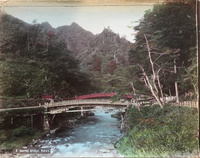
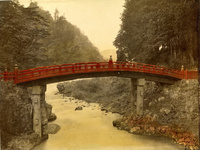
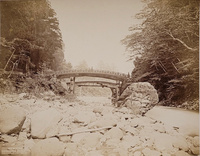
But Sturgis’s photographs of Japan also functioned as a form of cultural salvage, documenting the dying customs of what he believed to be an idyllic, premodern society on the brink of collapse.[27] A romantic feeling for transience and decay deepened his passion for architectural photography. Sturgis hailed the camera for creating a permanent record of “the perishing ancient buildings of Europe,” their façades “set full for the sun to shave” over many centuries.[28] In the unique case of Japan, he worried the sudden introduction of foreign commerce had accelerated the pace of cultural loss. Through a series of landmark essays and books, Sturgis described Japanese art and architecture, and Japanese culture more broadly, as rapidly vanishing under Western influence.
In 1868 Sturgis published “The Fine Arts of Japan” in The Nation, the earliest essay dedicated to Japanese art to appear in the United States. Written nearly a decade before most of Sturgis’s countrymen would discover Japanese goods at the Philadelphia Centennial Exposition of 1876, the article was both a beginning journey into Japanese culture and a wistful elegy mourning its demise.[29] Captivated by the aura of mystery hovering about Japanese art, Sturgis set out to elucidate some of the “dark questions” posed by Japanese woodblock prints, as well as decorative wares in lacquer, bronze, and ivory. What he began to sketch was the picture of a purer, more spiritual civilization, emerging from the preindustrial past. Sturgis admired the intertwining of Japanese art with religious themes, in implicit contrast to the crisis of faith afflicting the US in the post-Darwinian period. He marveled at Japanese art’s truth to nature and exceptional craftsmanship, which demonstrated the old, artisan values he felt were disappearing from the industrial West.[30] Sturgis later asserted, “The bygone age of art . . . was found in living shape in the islands of Japan,” and he urged Gilded Age artists and decorators to emulate Japanese standards of design.[31] However, Sturgis feared that the foreign demand for mediocre, mass-produced goods was enticing native makers to replicate the mechanical cheapness and uniformity characteristic of Western design. Japanese art was speedily “dying with the government of the Shogoon,” he claimed, “and a few years more of intercourse with Europeans will finish it.”[32] The idea that the rising demand for Japanese goods from the West was degrading their quality became a common refrain among US critics of the late nineteenth century.
To Sturgis, the fate of Japanese architecture appeared particularly precarious. A Pre-Raphaelite and medievalist, he found in Japanese building the virtues of simplicity, freedom, and honest construction that he associated with gothic architecture. The energetic curves of the Shinkyō’s deck and rails, and the visible mortise and through-tenon construction of its piers and crosspieces invited comparison with gothic workmanship. In his last major study, A History of Architecture (1909), Sturgis called Tokugawa building at Nikkō and elsewhere less subtle than earlier styles but still “refined beyond experience and beyond power of imitation.”[33] The fact that so much Japanese architecture was also wooden like the Shinkyō, and thus susceptible to fire, amplified his anxiety about its imminent destruction. First, fire posed a material threat to extant wooden structures. Second, Japanese architects seemed to be renouncing timber construction in favor of less combustible and more imposing masonry techniques from the West. Sturgis lamented the attempt of Japanese architects “to transplant to the Far East the entirely decadent architecture of the West.”[34] In a quixotic attempt to preserve Japan’s tradition of timber building, he proposed translating the system of wooden construction into bronze, an incombustible local material that posed “less risk of the loss of all natural charm, than if the indigenous building were abandoned altogether” for Western-style brick and stonework.[35]
Sturgis clearly viewed photographs as another means to preserve the “traditional Japan” before it was destroyed by Westernization and modernization. What is so fascinating about Vermilioned Bridge, Nicco, though, is that signs of the country’s rapid development, mainly Japanese photographers, haunt the very picture meant to arrest cultural change. Such dynamic subjects are unusual in the Sturgis archive. New hotels and urban street views with Western-style architecture, telegraph poles, and gaslights punctuate the collection, but seemingly timeless scenes of ancient temples and shrines predominate. More generally, nineteenth-century collections of Japanese photography in the United States heavily favored images of the old Japan, untroubled by the turmoil of contemporary life. They tend to express their owners’ disaffection with modernity and projections of exoticism, more than the realities of Meiji Japan.
Although Sturgis called photography “a mere glass through which one saw the veritable object” of study, the images of Japan that he collected ultimately mirrored his own desires and prejudices. They were a looking glass, not a transparent window into reality, reflecting his discontent with modern modes of production and consumption, his longing for spiritual values withering in the industrialized West, and his eagerness to encounter a faraway land of mystery and enchantment.
Acknowledgments
I thank Sonya Rooney, Jennifer Akins, and James Gardner at Washington University Libraries for their assistance with the Sturgis Collection. Small portions of this essay appeared in the digital exhibition catalogue Global Vistas: American Art and Internationalism in the Gilded Age (St. Louis: Mildred Lane Kemper Art Museum, Washington University in St. Louis, 2020), https://sites.wustl.edu/globalvistas/.
Notes
[1] For Japanese prints depicting photographers operating camera equipment, see Allen Hockley, “Cameras, Photographs and Photography in Nineteenth-Century Japanese Prints,” Impressions 23 (2001): 42–63.
[2] Advertisement in The Japan Mail Daily Advertiser, August 25, 1875, 3, and daily until October 6, 1875, 4; quoted in Luke Gartlan, “‘A Native Photographer of Rare Ability, Skill and Enthusiasm’: Uchida Kuichi and His Foreign Clientele,” in Yoake mae shirarezaru Nihon shashin kaitakushi I. Kantō hen kenkyū hōkoku (The Dawn of Japanese photography 1. Kantō Region) (Tokyo: Tokyo Metropolitan Museum of Photography, 2007), 23.
[3] Aris Kourkoumelis, “67. The Cruise of HMS Bacchante: 1879–1882. Vol V: Japan,” in Japan: Courts and Culture, ed. Rachel Peat (London: Royal Collection Trust, 2020), 124. I thank Aris Kourkoumelis and Luke Gartlan for discussing the attribution of Vermilioned Bridge, Nicco.
[4] Gartlan, “‘A Native Photographer,’” 20–21. For photographs from the imperial tour, see Kasumi Kaikan Shiryōtenji Iinkai, ed., Rokumeikan hizō shashinchō (Treasured Photograph Albums of the Rokumeikan) (Tokyo: Heibonsha, 1997), 196–240. For photographs as the record and symbolic embodiment of the gaze of the emperor on the imperial progresses, see Gyewon Kim, “Tracing the Emperor: Photography, Famous Places, and the Imperial Progresses in Prewar Japan,” Representations 120, no. 1 (Fall 2012): 115–50.
[5] For more on the use of portable darkrooms, field cameras, and other routine equipment and supplies in nineteenth-century Japan, see Karen Fraser, “Studio Practices in Early Japanese Photography: The Tomishige Archive,” History of Photography 33, no. 2 (2009): 132–44; and Annabelle Simon, “Nineteenth Century Japanese Photography: Techniques, Conservation and Restoration,” Association France Japon-Nord / Japan Society Symposium Les Collections d’Art Japonais en Europe, Lille, October 4–5, 1997, http://www.oldasiaphotography.com/pdf/researches/article-techniques.pdf. For firsthand accounts of the difficulties faced by wet-plate photographers in Japan, see Terry Bennett, Photography in Japan 1853–1912 (Rutland, VT: Tuttle, 2006), 306–8; and Terry Bennett, Old Japanese Photographs: Collectors’ Data Guide (London: Quaritch, 2006), 46–63. The introduction of dry-plate photography to Japan in the early 1880s vastly simplified the process of photographing on location. Dry plates could be purchased or prepared in advance, easily stored before and after exposure, and processed later in the studio. They obviated the need for a portable darkroom and the many chemicals necessary for preparing and developing wet plates on the spot.
[6] David Odo, Unknown Japan: Reconsidering 19th-Century Photographs (Amsterdam: Rijksmuseum, 2008), 25.
[7] John W. Dower, “Ways of Seeing, Ways of Remembering: The Photography of Prewar Japan,” in A Century of Japanese Photography, ed. Japan Photographers Association (New York: Pantheon, 1980), 9.
[8] “Notes of a Trip to Nikko,” The Far East, April 1, 1873, 244–45.
[9] “Notes of a Trip to Nikko,” The Far East, May 1, 1873, 272.
[10] Yokoyama Matsusaburō (1838–84) created a portfolio of Nikkō and its surroundings in 1870, and Baron Raimund von Stillfried (1839–1911) falsely advertised the first views of Nikkō ever photographed in 1875. Luke Gartlan, “Japan Day by Day?: William Henry Metcalf, Edward Sylvester Morse and Early Tourist Photography in Japan,” Early Popular Visual Culture 8, no. 2 (May 2010): 144.
[11] Anne Nishimura Morse, “Souvenirs of ‘Old Japan’: Meiji-Era Photography and the Meisho Tradition,” in Art & Artifice: Japanese Photographs of the Meiji Era: Selections from the Jean S. and Frederic A. Sharf Collection at the Museum of Fine Arts, Boston, ed. Emiko K. Usui and Mark Polizzotti (Boston: Museum of Fine Arts, Boston, 2004), 46–48; and Allen Hockley, “Packaged Tours: Photo Albums and Their Implications for the Study of Early Japanese Photography,” in Reflecting Truth: Japanese Photography in the Nineteenth Century, ed. Nicole Coolidge Rousmaniere and Mikiko Hirayama (Amsterdam: Hotei Publishing, 2004), 70.
[12] Robert S. Gardiner, Japan as We Saw It (Boston: Rand Avery Supply Company, 1892), 60.
[13] Morris Low, Japan on Display: Photography and the Emperor (London: Routledge, 2006), 3.
[14] For meisho-e and early Japanese photography, see Morse, “Souvenirs of ‘Old Japan’”; and Eleanor M. Hight, Capturing Japan in Nineteenth-Century New England Photography Collections (Burlington, VT: Ashgate, 2011), 81–84.
[15] For Hokusai’s popularity in the United States in this period, see Christine Wallace Laidlaw, “The American Reaction to Japanese Art, 1853–1876” (PhD diss., Rutgers, State University of New Jersey, 1996). A very similar composition by Uchida is Edo Castle, Babasaki Gate (before 1873; private collection), depicting the former residence of the shoguns and location of the new imperial palace. See Kinoshita Naoyuki, “The Early Years of Japanese Photography,” in The History of Japanese Photography, ed. Anne Wilkes Tucker et al. (New Haven, CT: Yale University Press, 2003), 56.
[16] Edward S. Morse, Japan Day by Day, 1877, 1878–79, 1882–83, vol. 1 (Boston: Houghton Mifflin Company, 1917), 60.
[17] Fraser, “Studio Practices in Early Japanese Photography,” 139.
[18] The Japan Gazette, September 28, 1876, 3; quoted in Gartlan, “‘A Native Photographer,’” 24.
[19] This number includes seventy-three photographs in the Washington University Archives, sixty-five photographs bound together in an album on Japan held at the university’s Kranzberg Art and Architecture Library, and thirty-four photographs in a supplemental folder to that album, also at the Kranzberg Library. For Sturgis’s collection of photographs as a whole, see David R. Hanlon, Inventory of the Sturgis Photographic Collection (St. Louis, MO: self-pub., 1997); and David R. Hanlon, Facades of Time: Photographs of Architecture from the Collection of Russell Sturgis (St. Louis, MO: self-pub., 2002).
[20] Everett P. Wheeler, “Russell Sturgis,” The City College Quarterly 5, no. 1 (March 1909): 10.
[21] In 1874 US expatriate Henry Smith Munroe received a letter from his father in Brooklyn praising views of Japan by a native photographer that were available in a local studio. Munroe confidently identified the artist as Uchida. Henry Smith Munroe Papers, box 3, Connecticut Historical Society, Hartford, CT; quoted in Gartlan, “‘A Native Photographer,’” 22.
[22] Sturgis eventually acknowledged the artistic promise of landscape photography. In “Artistic Photography Once More” (1902), he admitted, “it appears that where pure landscape is concerned there do not exist those hindrances which make the ‘artistic photograph’ in figure work a dream.” Russell Sturgis, “Artistic Photography Once More,” Scribner’s Magazine, August 1902, 255. For similar questions about photography’s artistic status in Japan and the art photography movement that emerged there in the 1890s, see Kaneko Ryūichi, “The Origins and Development of Japanese Art Photography,” in The History of Japanese Photography, 100–141.
[23] Russell Sturgis, “The Lesson of the Photograph,” Scribner’s Magazine, May 1898, 639. Sturgis repeated the glass metaphor in a review of Ralph Adams Cram’s Impressions of Japanese Architecture and the Allied Arts (1905), calling it a “great regret” that he had not seen Japan’s temples with his own eyes but through “the glass held up to me by photographs of all sizes and from all conceivable points of view.” Russell Sturgis, “Cram’s Japanese Architecture,” The Architectural Record, March 1906, 231.
[24] Russell Sturgis, European Architecture: A Historical Study (New York: The Macmillan Company, 1896), vi.
[25] For Sturgis’s impersonal style and his views on the nature of criticism, see Marjorie A. Pearson, The Writings of Russell Sturgis and Peter B. Wight: The Victorian Architect as Critic and Historian (PhD diss., City University of New York, 1999), 282–327. For Sturgis’s philosophy of the “didactic image,” see Maura Lucking, “‘Seeing Clearly What Is Good’: Russell Sturgis and the Didactic Image,” Thresholds 46 (2008): 68–87. Sturgis’s zest for photography made him the rare authority on Japanese art and architecture publicly to embrace the medium. Luke Gartlan has argued that Japanese specialists in this period developed a more vexed relationship with photography: they privately used photographs to record Japanese culture, although they outwardly disavowed their dependence on the medium, owing to its close association with a superficial kind of globetrotter tourism. Fearful of the taint of tourism, such experts relegated photography to a marginal status in Japanese visual studies. See Gartlan, “Japan Day by Day?.”
[26] Alternatively, views of the same structure taken from multiple angles and positions could be seen as compensating for the inability of individual photographs to capture the entirety of a great building. According to Sturgis, one drawback of architectural photography was that “the whole of a large building cannot be shown at once. . . . And no one will assert that a photograph of one front of a cathedral or of one angle of a palace is adequate as an architectural picture.” Russell Sturgis, “Art in the Schools. The New York Photographs,” Scribner’s Magazine, November 1899, 638–39.
[27] For the salvage paradigm and Japanese photography, see Luke Gartlan, “‘Bronzed and Muscular Bodies’: Jinrikishas, Tattooed Bodies and Yokohama Tourist Photography,” in Transculturation in British Art, 1770–1930, ed. Julie F. Codell (Farnham, UK: Ashgate, 2012), 93–94, 107; David Odo, The Journey of “A Good Type”: From Artistry to Ethnography in Early Japanese Photographs (Cambridge, MA: Peabody Museum Press, 2015), 87–112; Odo, Unknown Japan, 29; and Hight, Capturing Japan in Nineteenth-Century New England Photography Collections, 10–11, 107.
[28] Sturgis, “The Lesson of the Photograph,” 639. Sturgis drew the quotation, “set full for the sun to shave,” from Robert Browning’s poem “Old Pictures in Florence” (1855), which laments the loss of artistic masterpieces over time. For photography as a mode of architectural preservation in Sturgis’s writings, also see “The Historical Monuments of France,” The Architectural Record, January–March 1895, 308–11; “Ruskin on Architecture,” introduction to John Ruskin, The Seven Lamps of Architecture (New York: D. Appleton and Company, 1901), iv–v; and Sturgis, European Architecture, vii.
[29] For US interest in Japanese art and the increasing availability of Japanese goods in the 1860s and 1870s, before Japanism became widespread, see, among others, Laidlaw, “The American Reaction to Japanese Art, 1853–1876”; Henry Adams, “John La Farge’s Discovery of Japanese Art: A New Perspective on the Origins of Japonisme,” The Art Bulletin 67, no. 3 (September 1985): 449–85; and Ellen E. Roberts, “Marriage of ‘the Extreme East and the Extreme West’: Japanism and Aestheticism in Louis Comfort Tiffany’s Rooms in the Bella Apartments,” Studies in the Decorative Arts 13, no. 2 (Spring–Summer 2006): 2–51.
[30] Russell Sturgis, “The Fine Arts of Japan. I.,” The Nation, July 2, 1868, 16. For the full essay, serialized in five parts, see parts I through V, The Nation, July 2–September 10, 1868, 16–17, 56–57, 76–77, 96–97, 215–16. Sturgis’s celebration of traditional Japanese craftsmanship suggests that he may have been attracted to Vermilioned Bridge, Nicco by the photographers’ evident reprisal of such working traditions, as discussed above. In “The Fine Arts of Japan,” Sturgis also claimed to have studied more than three thousand woodblock prints and illustrations, including examples from a dozen books by “Oksai” (Hokusai), which he likely owned. Sturgis may have further admired the photograph’s resemblance to prints by Hokusai.
[31] Russell Sturgis, “Glimpse at the Art of Japan. By James Jackson Jarves,” The Nation, January 27, 1876, 68; Russell Sturgis, “Modern Architecture II.,” North American Review, April 1871, 370–71; and Lecture Notes on Japanese Art, Aldine Club, April 18, 1890, 2, Russell Sturgis Architectural Drawings and Papers, 1874–1932, Avery Architectural and Fine Arts Library, Columbia University, New York. Heeding his own advice about emulating Japanese design, Sturgis designed Japanese-inspired wallpapers for a firm in New York City. See “Culture and Progress: Art in Our Homes and Schools,” Scribner’s Monthly, February 1873, 514.
[32] Russell Sturgis, “The Fine Arts of Japan. III.,” The Nation, July 23, 1868, 76.
[33] Russell Sturgis, A History of Architecture, vol. 2 (New York: The Baker and Taylor Company, 1909), 54. For the honest construction of Japanese architecture and its relation to gothic workmanship, see Sturgis, A History of Architecture, vol. 2, 52: “In Gothic architecture, too, the designer does not seek for the appearance of ponderous dignity. He is more concerned with the expression of the construction, which alone suffices for his inspiration.” For the curved lines of Japanese architecture and their relation to gothic building, see Ralph Adams Cram’s essay on the “Architecture of Japan” in A Dictionary of Architecture and Building, vol. 2, ed. Russell Sturgis (New York: The Macmillan Company, 1901), 626: “The curves are not mathematical; they are as free and instinct with life as those of Gothic architecture.”
[34] Sturgis, “Cram’s Japanese Architecture,” 230. By contrast, Sturgis encouraged the elimination of wood as much as possible from US buildings as a means of fireproofing. See, among others, Russell Sturgis, “Good Things in Modern Architecture,” The Architectural Record, July–September 1898, 104–5; and Pearson, The Writings of Russell Sturgis and Peter B. Wight, 277–81.
[35] Sturgis, A History of Architecture, vol. 2, 44. Substantial considerations of Japanese art and culture by Sturgis also appear in “Across America and Asia,” The Nation, December 23, 1869, 564–65; “Mitford’s Tales of Old Japan,” The Nation, October 12, 1871, 245–46; “Fine Art as Decoration,” The International Monthly, May 1900, 463–92; “Two Works on Decorative Art,” The International Monthly, June 1901, 728–36; “The Oriental Series: Japan and China: Their History, Arts, and Literature. By Captain F. Brinkley,” The Nation, May 7, 1903, 381–82; “The Famous Japanese Room in the Marquand House,” The Architectural Record, September 1905, 192–201; A Study of the Artist’s Way of Working in the Various Handicrafts and Arts of Design, vols. 1 and 2 (New York: Dodd, Mead and Company, 1905); and The Interdependence of the Arts of Design (Chicago: A. C. McClurg & Co., 1905).